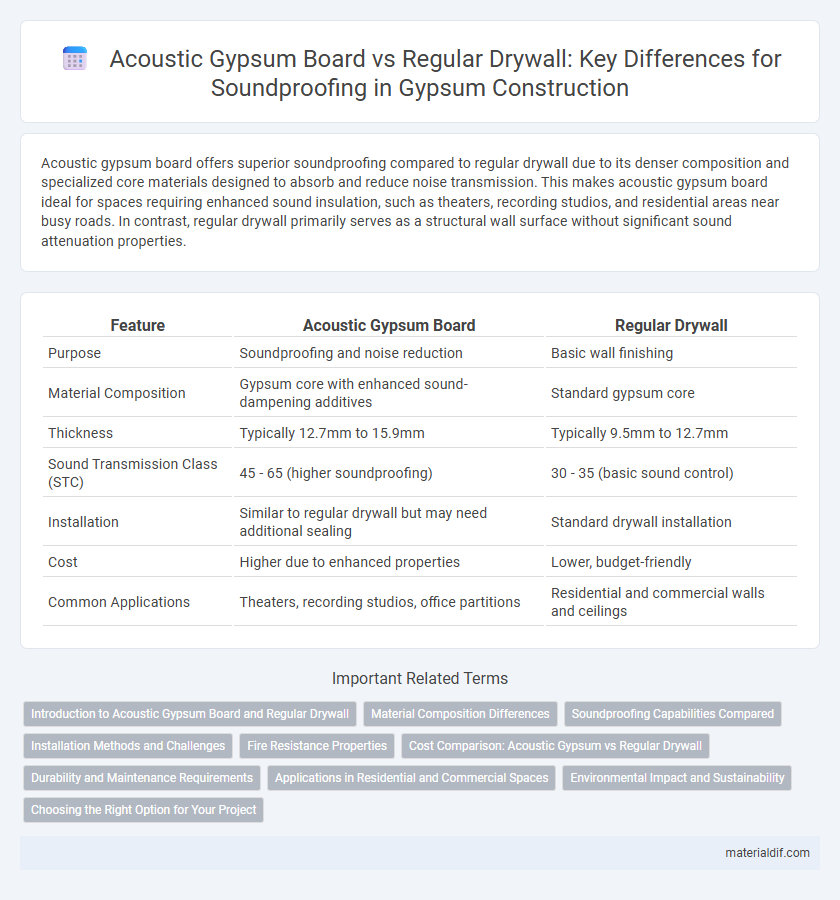Acoustic gypsum board offers superior soundproofing compared to regular drywall due to its denser composition and specialized core materials designed to absorb and reduce noise transmission. This makes acoustic gypsum board ideal for spaces requiring enhanced sound insulation, such as theaters, recording studios, and residential areas near busy roads. In contrast, regular drywall primarily serves as a structural wall surface without significant sound attenuation properties.
Table of Comparison
| Feature | Acoustic Gypsum Board | Regular Drywall |
|---|---|---|
| Purpose | Soundproofing and noise reduction | Basic wall finishing |
| Material Composition | Gypsum core with enhanced sound-dampening additives | Standard gypsum core |
| Thickness | Typically 12.7mm to 15.9mm | Typically 9.5mm to 12.7mm |
| Sound Transmission Class (STC) | 45 - 65 (higher soundproofing) | 30 - 35 (basic sound control) |
| Installation | Similar to regular drywall but may need additional sealing | Standard drywall installation |
| Cost | Higher due to enhanced properties | Lower, budget-friendly |
| Common Applications | Theaters, recording studios, office partitions | Residential and commercial walls and ceilings |
Introduction to Acoustic Gypsum Board and Regular Drywall
Acoustic gypsum board is specifically engineered with enhanced soundproofing properties, incorporating dense materials and specialized core designs to reduce noise transmission between rooms effectively. Regular drywall, commonly used in standard construction, primarily serves as a surface for finishing walls and ceilings without offering significant noise insulation. Comparing these, acoustic gypsum board provides superior acoustic performance, making it a preferred choice for theaters, studios, and residential spaces requiring sound control.
Material Composition Differences
Acoustic gypsum boards incorporate specialized additives such as viscoelastic polymers and sound-dampening fibers to enhance noise absorption, whereas regular drywall primarily consists of a gypsum core sandwiched between paper facings. The denser core and engineered layers in acoustic boards improve sound insulation by reducing vibration transmission. Regular drywall's uniform gypsum composition offers standard fire resistance and durability but lacks the advanced acoustic properties found in specialized gypsum products.
Soundproofing Capabilities Compared
Acoustic gypsum boards offer superior soundproofing capabilities compared to regular drywall by incorporating denser materials and specialized core designs that reduce sound transmission. These boards typically feature enhanced damping properties and mass that help absorb and block airborne noise, making them ideal for environments requiring noise control. Regular drywall lacks these specialized properties, resulting in less effective sound insulation in comparison to acoustic gypsum boards.
Installation Methods and Challenges
Acoustic gypsum board installation requires precise sealing and use of resilient channels or sound clips to enhance sound isolation, unlike regular drywall that primarily focuses on straightforward fastening with screws or nails. Challenges with acoustic gypsum board include maintaining airtight joints and handling heavier panels, necessitating specialized tools and techniques for proper mounting. Regular drywall installation is quicker and less complex, commonly involving standard framing attachment without the need for additional soundproofing components.
Fire Resistance Properties
Acoustic gypsum boards offer enhanced fire resistance compared to regular drywall due to their denser composition and fire-retardant additives, often meeting ASTM E84 Class A fire ratings. These boards can withstand higher temperatures and limit fire spread, providing critical safety advantages in commercial and residential construction. Standard drywall generally provides basic fire resistance but lacks the specialized materials that improve performance under prolonged heat exposure.
Cost Comparison: Acoustic Gypsum vs Regular Drywall
Acoustic gypsum board typically costs 20-30% more than regular drywall due to its enhanced soundproofing materials and specialized manufacturing process. While regular drywall averages around $10 to $15 per sheet, acoustic gypsum boards range from $15 to $22 per sheet, reflecting their superior noise reduction capabilities. Investment in acoustic gypsum board can reduce long-term expenses by minimizing the need for additional soundproofing treatments in residential or commercial construction.
Durability and Maintenance Requirements
Acoustic gypsum boards feature enhanced durability due to their higher density and special additives that resist dents and impacts better than regular drywall. They require minimal maintenance as their sound-absorbing properties remain effective over time without frequent repairs. Regular drywall tends to be more prone to surface damage and may need more frequent touch-ups and repainting to maintain its appearance and functionality.
Applications in Residential and Commercial Spaces
Acoustic gypsum board offers superior sound insulation properties compared to regular drywall, making it ideal for residential spaces such as home theaters, bedrooms, and multi-family units where noise control is crucial. In commercial environments, acoustic gypsum boards are frequently used in offices, conference rooms, and healthcare facilities to enhance speech privacy and reduce ambient noise. Regular drywall remains a cost-effective choice for non-critical areas due to its ease of installation and versatility but lacks the specialized acoustic performance required in sound-sensitive applications.
Environmental Impact and Sustainability
Acoustic gypsum boards are engineered with recycled materials and enhanced density to improve sound insulation while reducing environmental footprint compared to regular drywall. The manufacturing process of acoustic gypsum panels often incorporates eco-friendly additives and requires less energy, contributing to lower carbon emissions. Regular drywall typically involves higher resource consumption and generates more construction waste, making acoustic gypsum boards a more sustainable option for green building projects.
Choosing the Right Option for Your Project
Acoustic gypsum boards provide superior sound insulation compared to regular drywall, making them ideal for projects requiring noise reduction in theaters, offices, or residential spaces. Regular drywall is cost-effective and easier to install, suitable for standard interior walls where soundproofing is not a priority. Selecting the right option depends on the project's acoustic requirements, budget constraints, and installation complexity.
Acoustic gypsum board vs Regular drywall Infographic

 materialdif.com
materialdif.com